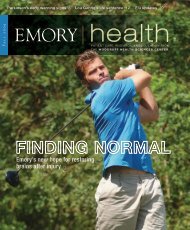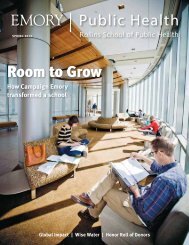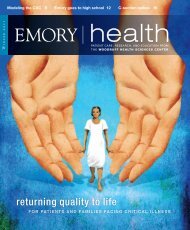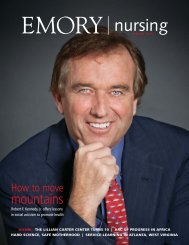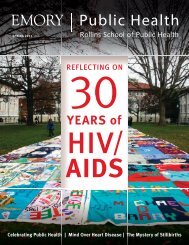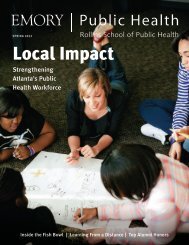Public Health Magazine - Fall 2008 - Woodruff Health Sciences ...
Public Health Magazine - Fall 2008 - Woodruff Health Sciences ...
Public Health Magazine - Fall 2008 - Woodruff Health Sciences ...
Create successful ePaper yourself
Turn your PDF publications into a flip-book with our unique Google optimized e-Paper software.
Left page: O. Wayne Rollins with his mother, Claudia Nance Rollins, at her Catoosa<br />
County home in northwest Georgia. Above left and center: Audience members Gary<br />
(left) and Ruthie Rollins and Bob and Danielle Rollins Henritze enjoy the groundbreaking,<br />
along with Peggy and Randall Rollins. Above right: Amy Rollins Kreisler (left),<br />
Michael Johns, and Fred Sanfilippo wait their turn on stage during the ceremony.<br />
Right: Former Emory health sciences leader Charles Hatcher (left) and former Emory<br />
President James Laney both supported creation of the RSPH in 1990.<br />
as the public health capital of the<br />
world,” he said.<br />
‘A fortunate problem’<br />
When James Curran became dean<br />
of the rsph in 1995, the school had<br />
occupied the Grace Crum Rollins<br />
Building for nearly a year. The<br />
school has since tripled its students,<br />
faculty, and research. Now the<br />
school has what Kreisler calls “a fortunate<br />
problem”—the need for more<br />
space. The Claudia Nance Rollins<br />
Building will enable the school to<br />
expand its physical capacity, recruit<br />
additional faculty, grow its research<br />
and education programs, and attract<br />
more students with the goal of<br />
becoming one of the top five public<br />
health schools in the world.<br />
“We cannot achieve those things<br />
without this building,” said Curran.<br />
“And we would not have this<br />
building and all that it represents<br />
without the vision and generosity of<br />
the Rollins family.”<br />
Slated to open in fall 2010, the new<br />
facility will have technologically so-<br />
phisticated “smart” classrooms, wet<br />
laboratories on three floors, offices,<br />
conference space, and an auditorium.<br />
It will support education and research<br />
in several key areas, including global<br />
health, predictive health, infectious<br />
disease, cancer, diabetes, and other<br />
chronic diseases. Conference capabilities<br />
will augment the development<br />
of training, distance-learning, and<br />
professional exchange programs. The<br />
Grace Crum Rollins Building will be<br />
renovated to enhance existing classroom<br />
and office space and provide a<br />
full-service cafe.<br />
The building has been a partnership<br />
from the beginning. slam Collaborative,<br />
the building architect, has<br />
based its design on ideas generated<br />
by rsph faculty, staff, students, and<br />
alumni; members of Emory’s health<br />
sciences and university communities;<br />
and the Rollins family. Filled<br />
with natural light and energy-saving<br />
features, the building is designed to<br />
achieve silver status for Leadership in<br />
Energy and Environmental Design.<br />
once it opens, the Claudia Nance<br />
Rollins Building also will enable the<br />
school to better serve the university,<br />
city, state, nation, and world, just as<br />
its multiple planners intended.<br />
“Many of our alumni think of<br />
themselves as Rollins graduates, and<br />
as those alumni practice what they<br />
learn here, hundreds of thousands<br />
of people throughout the city and<br />
the world know the Rollins name<br />
as a sign of hope,” Curran told the<br />
great-great grandchildren of Claudia<br />
Nance Rollins at the groundbreaking.<br />
“Most of those people will<br />
never know you, but like us, they<br />
will be grateful to you.”<br />
As the ceremony concluded,<br />
Kreisler reflected on what the new<br />
building and the rsph would mean<br />
to o. Wayne Rollins.<br />
“My grandfather once said that<br />
‘giving to a living institution that<br />
goes on and on and affects people’s<br />
lives—to me that’s the best. That’s<br />
the highest kind of giving when you<br />
invest in people.’ I can’t think of a<br />
better example of his philosophy<br />
than this school.” <br />
fall <strong>2008</strong> public health magazine 17



